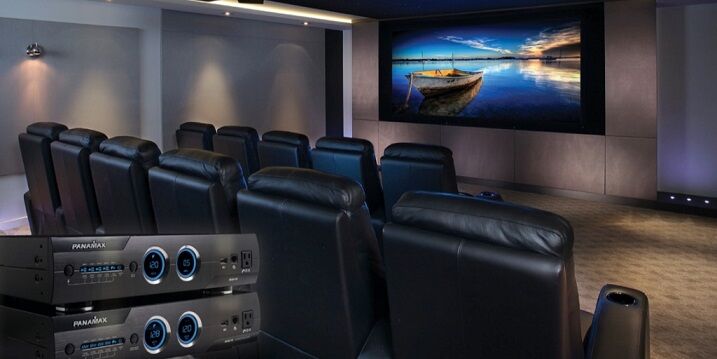When you’re ready to start your home theatre setup, one of the first things you’ll need is a power manager. This device will help to keep your system running smoothly and efficiently by managing the power going to your components.
There are a variety of options available when it comes to home theatre power managers, but which one is right for you? In this expert guide, we’ll review some of the best options on the market and help you choose the perfect one for your needs.
1. Cost: The first factor to consider is how much money you want to spend on your power manager. Some are cheaper than others, but all will get the job done.
2. Size and Design: Next, you should decide what size and design you prefer. Some are small and easy to carry around, while others are larger and more stationary.
3. Features: Once you’ve decided on the size and design, you need to decide what features you need the power manager to have. This includes things like battery life, different modes for powering devices, and more.
4. Compatibility: Finally, make sure the power manager is compatible with your devices and home theatre setup.
5. How Much Power Does It Take? The last thing you must consider is how much power the power manager needs to draw to work.
What is a home theatre power manager?

A home theatre power manager, or HPM for short, is a device that helps to manage and optimize your home theatre system’s power usage. By understanding your system’s current power draw and making necessary adjustments to your settings, an HPM can help you save money on your energy bill while keeping your home cinema experience top-notch.
There are a few different types of HPMs on the market, each with specific strengths and weaknesses. Here we’ll look at three popular models and provide expert tips on choosing the right one for your needs.
First up is the Power Saving Mode feature found in many budget-friendly HPMs. A Power Saving Mode is a simple but effective feature that allows you to automatically power your HT system on and off. This is great for those of you who are t in the habit of sitting down and turning off your system after each use. !!!You must have your HT system set to on !!! Before you can use this feature.
What are the Best Home Theatre Power Managers?
Are you looking for a home theatre power manager to keep your system running smoothly and efficiently? Look no further than our expert guide! We’ll discuss the different types of power managers available, their features, and which one is best for you.
1. Panamax MR4300 Power Line Conditioner and Surge Protector
If you’re looking for a power line conditioner that can handle a high surge current, the Panamax MR4300 is a good option. It has a rating of 1500 Joules and can protect up to four devices from spikes in electricity. Additionally, it features a 6-foot power cord and an automatic shut-off feature to help keep your devices safe. A The MR4300 is a little pricier than the other options, but it’s worth it if you need the extra surge protection.
The Panamax MR4300 is great for powering your home theater, lighting, and other electronic devices. A great option for the Star Wars fan in your life is the Star Wars Power Extender.
It’s a USB-powered power line conditioner that can use to keep all of your electronic devices powered up throughout the night. The Power Extender is compatible with both Windows and Mac devices. The device has a 9-foot cord and a convenient wall-wart power adapter. It also features surge protection and automatic shutdown to help keep your electronics safe.
2. Panamax MR5100 Line Conditioner
Panamax MR5100 Line Conditioner is a great home theatre power manager. It helps to manage and protect your expensive electronics by providing clean, reliable power. This device plugs into an outlet and manages the voltage and current delivered to your devices. It is compatible with most common devices, so you can be sure it will work with your equipment. The Panamax MR5100 Line Conditioner also has a LED indicator light that lets you know when it is working properly. A It also includes a fuse.
The Panamax MR5100 Line Conditioner comes with a 1-year warranty. The Panamax MR5100 Line Conditioner has an input voltage of 120VAC, 60Hz, and 400W. Amazon. Panamax MR5100 Line Conditioner Features: This device has a 120VAC, 60Hz, and 400W output.
3. Furman PL-8C 15 Amp
If you’re looking for a top-of-the-line home theatre power manager, the Furman PL-8C is a great choice. This unit has all the bells and whistles, including an SMP (symmetrical multipole power), EVS (exclusive voltage sensing circuitry), and LiFT (light frequency tuning) technology. Plus, it has 9 outlets to help you stay connected and organized. The PL-8C also has a convenient pullout LED light to help you see what’s happening in the dark.
What is Dirty Power?
In today’s world, there are many ways to power devices in the home. The most popular methods are electrical outlets and batteries. However, another option can be used to power devices in the home: dirty power. Dirty power refers to using electricity generated from solar panels or wind turbines that have not been cleaned or maintained properly. This type of power can harm the environment and your electronics, so it is important to know how to use it safely.
There are several ways to use dirty power safely. For example, you can set up a system where all your devices use clean power when possible, or you can use a power manager to automatically switch between different power sources depending on what is available. A power manager is a device that can install on your computer, phone, or tablet. It can help you automatically switch between different power sources depending on what is available.
There are many ways to power devices in the home, and each has pros and cons. Here’s a look at the most popular methods, plus our recommendation for the best home theatre power manager.
Electricity: This is still the most common way to power devices in the home, and it’s generally reliable and affordable. However, there are some downsides. For example, if your electricity goes out, all of your devices will shut down. And if you have a lot of electronic gadgets, you’ll probably need plenty of outlets (or cords) to support them all.
AC Power: This is becoming increasingly popular as an alternative to electricity because it’s more efficient and doesn’t rely on an electric grid. It’s also more convenient because you don’t have to plug in your devices, and you can use them without figuring out which cable goes where. It’s also a little safer than electricity since it doesn’t generate any dangerous sparks. However, it requires more space and is more expensive.
Solar Power: This is one of the most efficient ways to power your devices. You can use panels to charge batteries or even connect the solar panel to a battery pack. There are several options with this type of energy, including something as simple as building a solar-powered phone charger for your car.
Is a Power Manager/Conditioner the Same as A Surge Protector?
A power manager is a device that helps to protect electronic equipment from overload and surges. Power managers also offer protection from improper use of power, such as overloading during an audio or video production. Some power managers are also conditioners, which means they help to improve the overall electrical performance of a home theatre system. However, there is some confusion about the two terms.
A surge protector is designed to protect electronic equipment from spikes in voltage. At the same time, a power manager is more general and can protect electronic equipment and the home wiring itself from overloads and surges.
Power management is an important part of any electronic system. It’s essential to protect your equipment from overload and surges, which can damage it. There are a variety of power managers available, each with its benefits and drawbacks. This guide will discuss the best power managers for home theatre systems.
To choose the right power manager for your needs, you first need to consider what type of system you have. For example, a simple wall-wart power manager may be sufficient if you have a single AV receiver or TV. However, you’ll need something more powerful if you have more than one device connected to your TV or receiver (such as multiple TVs and Blu-ray players).
The standalone unit is the most popular power manager for home theatre systems. These units connect directly to your devices and manage their power loads. Some standalone units even have a USB port to charge your devices. While this type of power manager only handles power, it’s typically more powerful than the typical wall wart.
What are the benefits of using one?
The best home theatre power manager is a device that helps to manage the power used by your home theatre equipment. This can help to save on energy bills and ensure that all of your equipment is operated at its optimum performance. There are many benefits to using a home theatre power manager; below are just some.
1. Saving on energy bills: A home theatre power manager can help you to conserve energy in your home by managing the power used by your home theatre equipment. This can help you save on energy bills and ensure that all your equipment is operated optimally.
2. Ensuring optimal performance: A home theatre power manager can help ensure that your equipment operates at its optimum performance. This will ensure that your equipment is operating at its maximum level of performance and you are not losing out on the benefits of using a home theatre system.
What to look for in a power manager?
Home theatre power managers are essential for anyone looking to set up a home theatre. They can help you choose the right power supply, manage the power usage, and customize your Theatre settings. There are three main types of home theatre power managers: those that use batteries, those that use AC adapters, and those that use both. Below we will discuss each type in depth.
Batteries-powered power managers work with either AA or AAA batteries. The latter usually come with an adapter so that you can use them with an AC outlet. This type of power manager is convenient if you already have a lot of batteries around, but it cannot be easy to track how much juice is left in them.
AC adapters-powered power managers typically have a built-in AC adapter. AC adapters-powered power managers typically have a built-in AC adapter.
They operate on a timer and will turn your TV on and off with the flick of a switch or remote control, regardless of whether you are home or not. You can also power a TV using an AC adapter. You can also power a TV using an AC adapter. If you have an electric fireplace or fireplace insert, you can connect the power manager to it and run it as long as you want.
If you have an electric fireplace or fireplace insert, you can connect the power manager to it and run it as long as you want.
The best part is that there are many great options to choose from (and more are coming daily). If you’re looking for a way to optimize your home theatre system, you’ll want to consider investing in a power manager. A power manager is a device that helps manage your home theatre’s power usage and save you money on your electric bill. There are various options available on the market, so it’s important to choose one that will fit your needs and meet your requirements. Here are some tips to help you make an informed decision:
1. Consider your needs. What type of power management do you need? How will you be using it? Will you power your entire theatre system or just a few select components? Do you need to connect to your home’s electric grid, or will the power manager function on its own using batteries?
2. Consider your budget. How much are you willing to spend on a power management system? In addition to the cost of the product, you will also have to consider installation costs and maintenance.
3. Consider your needs. What type of power management do you need? How will you be using it? Do you need to connect to your home’s electric grid, or will the power manager function on its own using batteries?
4. Consider your budget. How much are you willing to spend on a power management system? Power Management Systems: Operation and Maintenance Power management systems are used to control the power that is being consumed by a device. They can reduce the energy a device uses or distribute electrical power over several devices for greater efficiency and reliability.
How does a Home Theatre Power Manager Work?
Home theatre power manager (HTPM) is a small yet powerful tool that can help you manage your home theatre system. HTPM not only helps to save energy, but it can also improve the sound quality and overall experience of your home theatre.
HTPM comes in two forms- a plug-in device or an app. The plug-in device is a small black box on your power outlet near your home theatre equipment.
The first step in using HTPM is determining how much power your home theatre consumes. This is done by connecting the HTPM to your home cinema system and entering the total watts used.
The next step is configuring HTPM to use the least amount of power possible.
For example, if you have a home cinema system with 16 speakers and your HTPM is connected to the AVR, you should select the ‘SPDIF’ option as this will use the least power.
How to Choose the Right Home Theatre Power Manager: Guidelines for selecting the best power manager for your needs.
When choosing a home theatre power manager, there are a few key factors to remember.
First and foremost, the power manager should be capable of meeting the specific needs of your home theatre system. For example, if you have a large-screen TV, you’ll need a power manager to provide enough juice to run it smoothly. On the other hand, if your home theatre system consists of only a couple of small screens and stereo components, then a lower-powered power manager may be adequate.
Another key consideration is how frequently the power manager will be used. If you plan on using your home theatre system only occasionally, then a low-power or battery-only option might be fine. However, if you typically use your home theatre system several times per week, you’ll likely want to invest in something that can provide continuous power.
The next decision you’ll need to make is whether you wish your home theatre system to be powered by a dedicated power supply or a normal power outlet. A dedicated power supply provides a higher-quality connection to your home theatre system. This will allow you to use more expensive cables, providing better signal quality and fewer signal losses than ordinary power cables.
You were setting Up and Using Your Home Theatre Power Manager:
Like most people, you probably think of home theatre as a place to enjoy your favorite programs and movies. But before you can enjoy them, you must ensure your home theatre is up to the task. That’s where a good home theatre power manager comes in.
A power manager can help reduce the workload on your A/V equipment by automatically shutting down or powering down devices when they’re not in use.
In addition to saving energy, a power manager can keep your system running smoothly and prevent potential problems. When you’re shopping for a power manager, you’ll want to consider the following factors:
How much power do I need? As we discussed in Part 1, there are different levels of A V equipment. Therefore, the power manager you choose will depend on your system type. For example, a power manager designed for home theatre systems might be unable to power a computer or a printer. In addition, the amount of power your A V equipment needs may change over time.
Conclusions:
The best home theatre power manager is a device that can help you manage your entertainment system’s power consumption. Doing so can save energy and money on your electric bill. Several different types of home theatre power managers are available on the market, so it is important to choose the one that is right for your needs.
The three main types of home theatre power managers are programmable switches, smart plugs, and outlet strips. All three have their advantages and disadvantages. Programmable switches are the easiest to use, but they may not be compatible with all devices in your entertainment system. Smart plugs are more versatile, but they require an internet connection to function. Finally, outlet strips are the most powerful option, but they can be more difficult to install.
Ultimately, it is up to you to decide which type of home theatre power manager is right for you.








